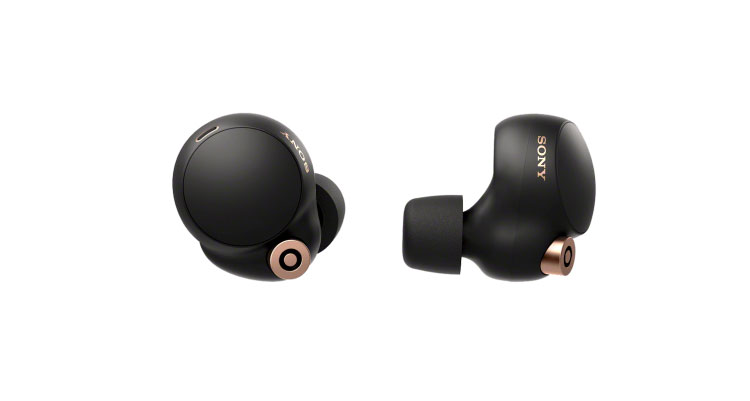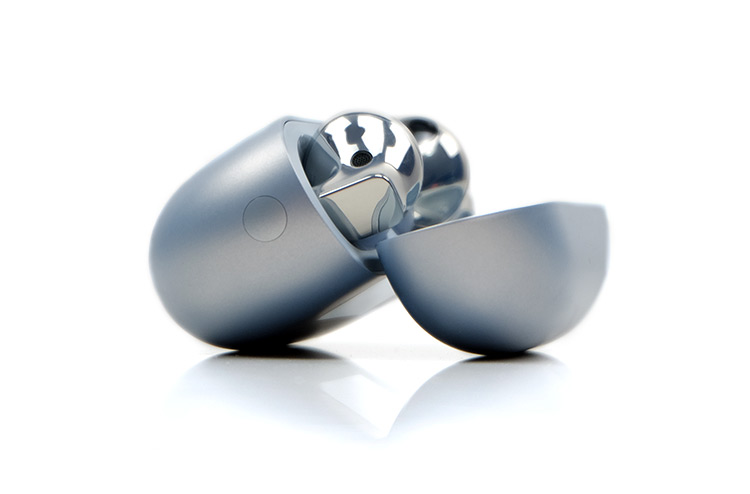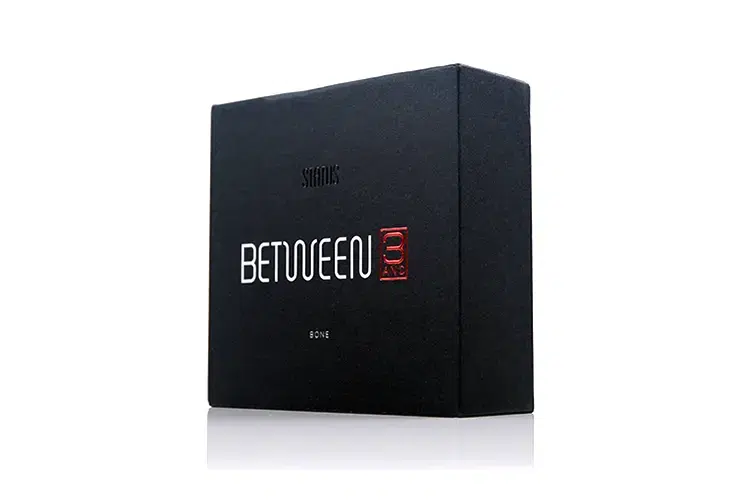Select Comparisons
The following comparisons were completed using a Samsung S23 Ultra and an Apple iPhone 14 as the main wireless transmitters. All TWS were fitted with their stock tips for all testing and set to their default sound signature modes.
Sony WF-1000XM4
As of writing today, the XM5 has just been released so the WF-1000XM4 is no longer the flagship TWS from Sony though it is still widely available to buy.
Technical
Pretty much everything about the Sony WF-1000XM4 is designed in-house from the driver to the SoC and the external design. Sony is an electronic behemoth capable of doing that.
Inside, it sticks with the single 6mm dynamic driver size as with the previous generation though this is an updated design to tie in with an improved ANC performance and improved bass.
On paper, the 3ANC outdoes the Sony with a bigger 10mm dynamic driver and those two additional BA drivers to cover the mids and highs. This is a more complex driver configuration.
However, Sony has a trump card and that is LDAC. Bring able to receive an LDAC transmission can make an audible difference to sound quality if done correctly. The 3ANC can only decode up to 16BIT/48 kHz with its SBC technology and 24BIT/44.1kHz with AAC. That it is some way short of the 24BIT/96kHz capability of the Sony.
On top of that, the WF-1000XM4 has some excellent ANC capability. The 3ANC is just as good, if not better, for passive isolation and way more comfortable in the ear also. However, its ANC is a bit behind Sony in general noise-suppressing performance.
Both TWS have stylish-looking app designs with the 3ANC the more intuitive to use once connected. However, the Sony Headphones app is the more feature-rich of the two including 360 Audio access, more customizable button, and ANC levels.

Design
The WF-1000XM4 looks more like an IEM with some nice aesthetics but is not as unique as the 3ANC. Despite being more of an ‘IEM’ the Sony fit is not that great whereas the 3ANC is excellent.
A factor is those stiff and thick hybrid tips Sony use. It’s not as if you can just go down a size and improve the comfort levels because in doing so the ANC and general passive isolation levels take a small hit. I tend to use the large tips to keep them in place and maximize isolation but the pressure on the canals can get pretty strong after an hour or two.
The 3ANC drivers I could wear for ages with plenty of fitwing and tip combinations to get the exact fit I want. Granted, they stick out of your ear a lot more and have a higher level of visibility but I would take that over any ear discomfort.
Both are touch control based though the 3ANC does have that additional button on the base of the stem for power and battery status. The Sony touch controls are similar in nature though you can vary them via the app and have different actions for each side of the driver.
There isn’t a huge amount of difference in the cradle design either. Both are fairly low-profile with nice curving. The 3ANC cradle is a shade larger. Both are fitted with USB-C with charging times around 1.5 to 2 hours depending on how much juice is depleted. You also get feature wireless charging Qi technology on both.
Battery capacity is also similar with both claiming 12 hours without ANC and 8 hours with ANC. The Sony’s cradle’s battery capacity is rated for 24 hours, less than the 30-hour rating of the 3ANC cradle.
Performance
The 3ANC has a more exaggerated frequency response with an emphasized sub-bass and a stronger mid-bass punch. It also has a stronger 1-4k mids elevation pushing vocals front and center.
Finally, there is a lot more sustained energy from 5-9k and you should be able to pick that up also in the mids coloration given the elevated upper-mids tuning.
The Sony is warmer and more relaxed in its response curve. It does have some bass emphasis but it is a very saturated and slow-moving performer with a longish decay and less punch.
The Sony mids are more neutral in their positioning compared to the 3ANC. You do benefit from more perceived space but vocals lack the same immediacy. What you get in return is a smoother timbre and a little more nuanced detail in the texture also from the more resolving LDAC profile.
The 3ANC mids instrument and vocal are right there in front of you pushing instruments further back with thinner lower-mids that sit even further behind. Upper-mid percussion has more energy, a slightly drier tone from the BA drivers, and picks up a bit from the stronger treble in its high contrast harmonic balance.
Here the Sony is darker sounding with a decided dip post 5k. It has less percussion energy and they are less likely to shine though its smoother tonal profile gives a more forgiving character.
There is a slight edge to the Sony with LDAC in play. It can sound more refined at times with a little more imaging complexity but just let down slightly by the darker treble performance. The 3ANC will generally sound more high-impact and energetic but can overcook the treble at times without EQ.
Huawei FreeBuds Pro 2
The FreeBuds 2 was launched by Huawei around the middle of last year and its been in my daily circulation of TWS since receiving them. At around $200 it’s also pitching at the same price point as the 3ANC.
Technical
The FreeBuds 2 Pro and the 3ANC are BT5.2 hybrid driver TWS though the Huawei dual-drive configuration is a little more unique. It has a slightly larger 11 mm dynamic driver for the lows compared to the 3ANC 10mm version and uses a single planar diaphragm driver instead of a dual BA for the rest of the range.
Both TWS come with ANC as standard though as mentioned on page 1 the FreeBuds 2 performance has a small edge across the entire FR.
It also has multiple levels of ANC control within its AI Life app compared to just 1 inside the Status 3ANC app. Both have transparency modes also should you require more situational awareness when using the buds.
Like the Sony, the FreeBuds2 Pro has up to LDAC receiving and decoding capability which pushes it ahead of the 3ANC’s SBC and AAC top-tier decoding limits.
The apps themselves do differ but in the case of Huawei, you do get more value using it with their phones with a more integrated approach across their phones. However, the AI Life app is very slick and well laid out with plenty of features.
The 3ANC does have some similar features such as the sound profiles and the ability to gauge the battery status of the drivers as well as update the firmware. However, it lacks the Ai Life’s ability to customize controls, locate earphones much like an AirTag as well as check on the cradles remaining battery life.
Design
Both designs are stem-type TWS designs though the FreeBuds 2 is more of a homage to Apple whereas the 3ANC has its own unique identity. The FreeBuds 2 Pro is smaller and lighter and arguably more sleek in its curving.
However, it’s a fingerprint magnet, and that sleekness can work against it when inserted into the ear as it tends to slowly slide out of your ear with prolonged use. I have used these many times on flights and they will fall out of your ear if you are not careful.
I do not get that feeling with the 3ANC whose silicone fit wing and ear tip combo keep it much more secure in your ear. Both have equal levels of comfort though with the FreeBuds 2 Pro edging it a little purely because it is a bit lighter and smaller.
I much prefer the touch controls of the 3ANC so. I have never enjoyed poking around the sides of thin stems to adjust volume or change tracks. It always feels so random when quickly trying to find the right control. The 3ANC touch surface area is more intuitive and easier to find unsighted with your finger.
Both have nice cradles and color options. Bone, black or blue frost, silver, and white. It’s a very modernistic lick of paint on both. I am ambivalent about preferences for the cradle designs. Both are minimalistic though the enhanced curves of the FreeBuds 2 Pro means they must lie flat rather than upright.
Battery life is far superior on the 3ANC with 12 hours passive and 8 hours ANC as opposed to 6.5 hours and 4 hours from the FreeBuds 2 Pro. Both cases though will offer you up to 30 hours of additional capacity with wireless charging.
Performance
The FreeBuds 2 Pro has a very smooth tone and timbre compared to the 3ANC courtesy of that planar and dynamic driver combo. I would argue it’s a more natural sound with a slightly longer more accurate rate of decay in the notes compared to the drier tone of the 3ANC.
However, I would also argue that the FreeBuds 2 lacks a bit of bite and punch with an FR that drops in the mid-bass and stays quite flat to around 600-700Hz.
Granted, I love the lack of bass bleed but the only time you are going to get a sense of any bass is when notes register south of 50-60Hz. So, yes, it is excellent for sub-bass with lots of bass-to-mids separation but not as punchy or as dynamic in its performance compared to the 3ANC tuning.
Of course, with more separation the FreeBuds 2 Pro does not need to be as emphasized in the 1-4k region to counter, something which the 3ANC does. That means the vocal imaging is more neutral and natural giving a stronger perception of space, separation, and staging width
The 3ANC upwards curve from 1-5K is much stronger pushing vocals front and center and instruments and acoustical backgrounds cues further behind. You get the twin towers of bass and vocal but lower mids and background imaging trails giving it a slightly narrower more intimate presentation.
Timbre from the mids to the highs is so different for each. The 3ANC is solid, clear but slightly dry, and less complex in textured detail. It can sound sharper at times also. The FreeBuds 2 Pro planar texture offers more textured detail with a slight 6k and 8-10k bump that gives it a minor overtone but nothing too sharp.
Samsung Galaxy Buds2 Pro
The Buds2 Pro is positioned a bit closer to the consumer side of the market with its close alignment to Samsung’s smartphone range. That being said, at over $200 SRP, it’s not a casual purchase and is very close to the 3ANC price point.
Technical
Both of these TWS use a multi-driver configuration but vastly different ‘blends’. The 3ANC is more of a classic hybrid 10mm dynamic driver for the lows and a dual BA design for the mids and highs.
The Buds2 Pro uses a 10mm woofer combined with a smaller 5.3mm tweeter, (both dynamic). That 2-way is split between the lows for the 10mm and the mids/highs for the tweeter.
Both have a modern BT profile with the 3ANC using BT5.2 and the Buds2 Pro bang up to date with the latest BT5.3 version. ANC is different for both. The 3ANC cancellation was more evenly spread with the Buds2 Pro superior for low-frequency noise cancellation but slightly inferior for high-frequency blockage.
Neither offer LDAC decoding though Samsung’s in-house Seamless codec supports up to 24-bit audio with a maximum bitrate of 512Kbps. The 3ANC offers a more traditional SBC and AAC level of codec support.
The greatest asset for the Bud2 is its integration into the Samsung eco-system. The Samsung Wearables app is very in-depth with a massive array of options. This includes multiple ANC and ambient sound controls and even earbuds geo-tracking in sync with Google.
On the audio side, you have 360 audio and EQ, with the ability to seamlessly switch earbud connection with multiple devices connected to one Samsung account.
The 3ANC does have some advantages over the Buds2 Pro such as a customizable EQ and perhaps very importantly, an app that is compatible with iOS. There is no applicable Samsung app for iPhones so you lose a lot of those features.
Design
I guess you could loosely phrase ‘small and cute’ versus ‘unique and stylistic’ when comparing these two. The Bud2 Pro drivers really do look like two little jellybeans slipped into a powder case such is the diminutive design for both the buds and the case. They are much smaller than the 3ANC.
The IPX7 design is slick with various color schemes and very smooth to the touch with no edging anywhere. Whereas the IPX5-rated 3ANC drivers are extravagant, angular, and eye-catching with lots of edges but smooth where it counts, in the ear.
The Buds2 pro fit is interesting. They sort of rest in your ear as opposed to the more traditional fit of the 3ANC. Both are very comfortable with great isolation but the sensation of wearing the tiny Buds2 Pro always makes me feel like they are barely in your ear with the ANC working hard to keep everything quiet.
The use of ANC on the Buds2 Pro is, in a way, a bit of a clever disguise because without it the passive isolation is not great, and not to the level of the 3ANC with a well-matched set of tips.
You do get a better battery life from the 3ANC at 12 hours without ANC and 8 hours with ANC as opposed to 8 hours and 5 hours for the Buds2 Pro. Both cradles will give you around 30 hours of additional capacity as well as wireless charging.
Performance
Of all the compared TWS the Buds2 Pro measures the best and by that I mean it adheres to most audiophile norms giving it a fairly balanced-looking frequency response.
However, it has one glaring weakness and that’s a strong 6-7k bump that bleeds into a lot of the midrange harmonics giving vocals a steely edge to its sound when pushed hard.
Now, the 3ANC also has some treble bleed but it’s not as striking unless you switch to the Between Pro classic sound signature profile. The bass warmth is stronger on the 3ANC and that is a relatively good counter combined with less narrowband peaking in the highs. It’s simply not as distracting or as disconcerting as the Buds2 Pro’s incisor-like sibilance.
The vocal timbre on the 3ANC is generally smoother but more elevated and in your face. The Buds2 Pro has a better vocal image, is not as shouty, and could be less fatiguing save for the sharp sibilance.
From the bass to the lower mids the Buds2 Pro though is quite correct and more balanced in both tone and emphasis with a sub-bass up there with the 3ANC but slightly less mid-bass punch and a flatter upper-bass to lower mids. The separation is excellent creating some nice space and giving it more flexibility for lighter instrumental arrangements as well as EDM.
Its default Status Signature sound profile lends itself more to modern pop and EDM than lighter arrangements. The 3ANC bass is punchier with more bloom that will overshadow the lower-mids leaving them sitting behind its stronger upper-mids imaging.
You can use the Status Audiophile signature if you want to tone down the bass emphasis but I prefer to do my own custom EQ to bring down both vocal and bass presence a shade.
Our Verdict
The Status Between 3ANC is a unique ‘indy’ offering. It has great looks, excellent battery life, and plenty of sound profile choices combined with an effective EQ option. The stability and range of the BT reception is one of the best I have tested.
The drivers are also deceptively comfortable on the ear though its ANC performance slips a little behind some of the main competition at this price point.
That does leave one area out that should title with a question of ‘what if’? What if the 3ANC had LDAC or aptX Adaptive and perhaps a stronger ANC? I think audiophiles would sacrifice a few hours of battery life just to see what those drivers could really do with a higher level of uncompressed audio data.
For a TWS with ‘only’ SBC and AAC code ability, it still competes well with some higher code-capable offerings. The hybrid driver combination is clearly able to deliver a competent performance but with that codec caveat the micro-detail is a little gimped.
Status Between 3ANC Specifications
- Driver: Triple driver system (10mm dynamic/2x Balanced Armature)
- Sensitivity: 105 dB SPL/mW
- Frequency response: 5hz-25,000hz
- Bluetooth: 5.2
- ANC: Yes
- Battery life: 8 hours (ANC on) / 12 hours (ANC off)
- Water resistance: IPX5 waterproof rating







